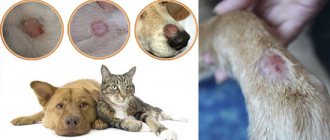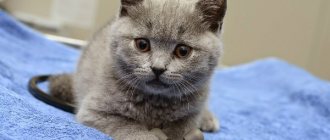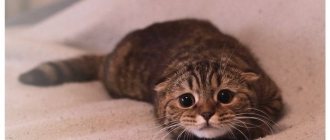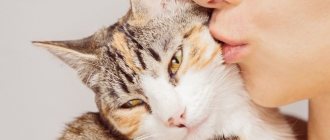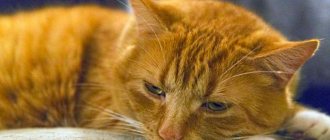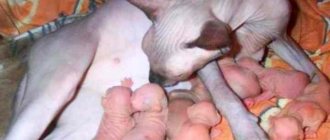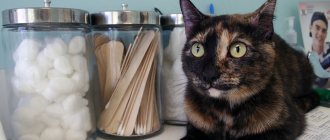What will you learn from the article?
- Causes of rickets in cats
- Symptoms
- Diagnostic methods
- Treatment Nutrition for rickets
A kitten is a child who is growing, and during this process he can develop various diseases. Rickets in kittens is a growing disease. Among ordinary people there is an opinion that this disease is caused by a lack of sunlight. In fact, rickets develops against the background of impaired metabolism and deficiency of vital vitamins and minerals.
If for some reason a growing body lacks vitamin D, calcium and phosphorus, malformations of the musculoskeletal and nervous systems occur. Due to a lack of microelements, the kitten’s skeleton develops incorrectly, it develops a rickets physique, and the pet lags behind its peers in development.
It is important to identify this disease as soon as possible, since the consequences of rickets can be irreversible. The disease, detected at an early stage, is treatable.
Causes of rickets
This pathology is of two types:
- The congenital type develops in kittens as a result of poor quality and unbalanced nutrition of their mother.
- The acquired form appears in those babies who are not well cared for. Often the disease develops against the background of long-term viral and chronic pathologies, diseases of the digestive organs, liver or kidneys.
The cause of the disease is also insufficient intake of vitamin D into the animal’s body, a lack of essential vitamins - phosphorus, magnesium, potassium, calcium.
A congenital disease can appear immediately after the birth of a kitten. It is provoked by:
- premature mating of the cat or her illness at this moment;
- exhaustion of the animal or the presence of genetic abnormalities;
- insufficient amount of taurine contained in the body of a pregnant female;
- lack of protein in the diet;
- mating with cats of related origin (usually many sick kittens are born in such a litter);
- frequent matings;
- lack of vitamins and minerals in a cat during pregnancy.
Factors that provoke the development of the acquired form of rickets in children:
- lack of sun and lack of fresh air;
- feeding with low-quality breast milk substitutes;
- early weaning from the mother and the same early transfer of the kitten to solid food;
- lack of vitamins and minerals in the feed;
- malabsorption of nutrients.
Rachitis: features and consequences
Rickets, or hypovitaminosis D, is a pathology (demineralization) of bone tissue. It occurs due to a critical lack of vitamin D in the body, a regulator of calcium and phosphorus metabolism necessary for bone growth.
In the first six months of life, meowing cubs undergo active bone formation. Therefore, a lack of vitamin D is especially dangerous. Its acute deficiency is fraught with the development of rickets in kittens. The main symptom of the disease—violation of ossification—is far from the only one.
A chronic and systemic disease develops over several weeks and results in a complex of complications:
- anemia;
- exhaustion;
- bronchopneumonia;
- catarrhal gastroenteritis;
- myocardial dystrophy;
- umbilical and scrotal hernias;
- decreased resistance to infections.
The presence of a “bouquet” of deviations causes growth retardation and developmental delays. Doctors classify such patients as hypotrophic; in everyday life they are called “little ones.” A sick animal really looks unsightly: with a large head, short legs and a “frog” (saggy) belly.
Is vitamin D always to blame?
Almost all owners are inclined to believe that rickets can develop solely due to a lack of vitamin D. To replenish it, they begin to give the animals fish oil in large quantities. In this case, the vitamin deficiency can actually be replenished (sometimes there is an excess of it in the body), but the disease remains. Moreover, it begins to imperceptibly undermine the baby’s health, sometimes remaining in his body throughout his life.
Rickets can also develop due to calcium deficiency. No matter how much vitamin D is supplied, bone tissue does not grow enough due to calcium deficiency. This is how the symptoms of rickets arise. If there is too much phosphorus in the blood, it begins to block the absorption of calcium, causing the body to suffer.
Main causes of hypovitaminosis D
In order to prevent dangerous metabolic disorders in furry young animals, you need to know what factors provoke them. As veterinary practice shows, these include:
- Incorrectly formulated diet for a pregnant cat mother. Lack of food or imbalance of proteins, essential amino acids, such as taurine, vitamins D, C, E, phosphorus, magnesium, calcium.
- Neglect of the rules of breeding cats: attracting an unformed female to mating; frequent matings, during which the body of a constantly giving birth cat is depleted; crossing of related animals; admission to mating of a weakened or obese partner.
- Violation by the owner of sanitary and hygienic standards for keeping kittens. To raise healthy offspring, sufficient humidity and good ventilation in the room are necessary. The baby should be outside during the daytime, since sunlight is the most important catalyst for metabolic processes in the body.
- Deviation from the requirements for feeding babies: inadequate complementary feeding of weaned kittens (mixtures from a dairy kitchen, cow's milk), a sharp transition to self-feeding, inadequate dry food with a lack of valuable additives - participants in metabolism.
- Gastrointestinal problems of a parasitic, infectious or enzymatic nature that prevent beneficial substances from being absorbed into the blood.
Symptoms of the disease
Typically, a breeder identifies rickets in a small kitten by the following signs:
- significant lag in growth and development compared to other kittens in the litter;
- lack of communication with his fellows, prefers to sit unnoticed in the corner;
- conditioned reactions are usually slowed down;
- the back of the animal sags, and the belly increases significantly;
- the spine and legs are noticeably curved;
- the gait is unsteady and uncertain, sometimes with a noticeable limp;
- no change of teeth is observed;
- joints are usually increased in size;
- the ribs are flattened.
Sometimes the animal develops diarrhea, muscle spasms, shortness of breath and a severe cough. These are secondary signs indicating the development of this pathology.
Symptoms with photos
A protracted disease is practically untreatable, so it is very important not to miss the first alarming symptoms. When congenital, they appear approximately 2 weeks after birth.
At a young age
The first signs of rickets in kittens include the absence of a sucking reflex. Sick babies cannot find their mother's breast without human help. Because of this, they do not gain the required weight and look exhausted. The locomotor activity of such animals is minimal. They practically do not communicate with their fellows and prefer to sit in the corner.
Over time, the symptoms increase:
- slow reaction to stimuli;
- delayed change of teeth;
- increased appetite, which does not eliminate unhealthy thinness (perversion of taste, that is, eating inedible objects, is also possible);
- sagging of the back and a significant increase in the abdomen;
- curvature of the spine and paws;
- unsteady gait and lameness;
- an increase in the size of the joints and thickening of the ribs (when stroking the sides, hard balls can be clearly felt).
Additionally, stool disturbance, cough and shortness of breath may occur. Please note that modification of the skeleton leads to very serious consequences that are difficult to treat with drug therapy. A favorable prognosis is typical only when the diagnosis was made soon after the problem with the sucking reflex was identified.
In adulthood
Lack of physical activity gradually leads to muscle atrophy, so even more alarming signs are observed after reaching 1 year. By this point, the animal’s entire nervous system is affected. This is accompanied by the appearance of muscle cramps, spontaneous sprains and bone fractures.
In adulthood, the likelihood of successful recovery is minimal. A sick pet runs the risk of remaining disabled for the rest of his life, since at the time of treatment he has many associated complications.
At what age does the disease appear?
Rickets can manifest itself between the ages of 2 weeks and up to six months. During this time, babies need to be examined daily. It is necessary to closely monitor the growth of kittens, since even a slight lag from normal indicators indicates the development of very severe pathologies. As the kitten gets older, the symptomatic picture becomes more pronounced and intense. It can be extremely difficult to control the disease in older age.
Consequences of rickets
Rickets is a dangerous lesion of bone tissue in the form of thinning and curvature. In addition, pathology causes disturbances and disorders in the functioning of all organs and systems. The consequences of the disease are:
- subsequent gradual curvature and irreversible thinning of the bones, as a result of which the cat remains disabled for life;
- chronic inflammation and destruction of cartilage and tissue;
- disruption of the liver and the entire gastrointestinal tract;
- reducing to a minimum the process of absorption of vitamins and microelements, causing the pet to lose a lot of weight and constantly get sick;
- development of severe convulsive seizures;
- development of oxygen starvation.
Further progression of these phenomena is associated with a high risk of death of the cat.
How to treat rickets in kittens
Any delay can aggravate the situation, so rescue procedures begin immediately after diagnosis. The main goal of therapy is to eliminate the existing deficiency. For this purpose, the pet’s diet is reviewed and special medications are prescribed.
Vitamin D replenishment
To replenish vitamin D during rickets, kittens are prescribed subcutaneous injections and the drug Tetravit. Taking capsulated fish oil is also recommended. It not only fights vitamin D deficiency, but also helps normalize phosphorus levels.
The owner needs to change the living conditions of the pet by moving it to a well-lit and dry room with good ventilation. If possible, it is recommended to take the patient outside so that he receives a sufficient amount of ultraviolet radiation from the sun's rays.
Nutrition
It is recommended to transfer newborn babies to special artificial formulas that correspond in nutritional value to the breast milk of a cat, and not of another animal. They can be purchased at veterinary pharmacies and pet stores.
When feeding naturally, the diet includes foods fortified with vitamin D:
- kefir and cottage cheese;
- sea fish;
- beef liver;
- chicken egg yolks.
You can also completely switch to ready-made dry food from the medicinal line. All standards have already been taken into account, so there is no need to be afraid of a shortage or surplus of some elements.
Taking medications and procedures
The list of recommended medications depends on the extent of damage to internal organs. It may include:
- cardiac glycosides (Adonizide) and ACE inhibitors (Prestarium), restoring contractile function and blood supply to the heart;
- antioxidants (Trimetazidine, Bionormalizer), which accelerate metabolism;
- enzymes (Mezim, Pancreatin) that restore the functioning of the digestive system;
- chondroprotectors (Glucosamine, Chondroitin), preventing the destruction of cartilage and bone tissue;
- hepatoprotectors (Karsil, Galstena), restoring liver cells.
In case of severe damage to the body, infusion therapy is required. To support the heart and stimulate the respiratory system, the mustachioed patient is administered drugs with magnesium and analeptics (Cordiamin, Camphor). Vitamin and mineral balance is also restored with intravenous drips.
Additionally, a course of quartz treatment and massages is recommended. If the treatment period falls in winter, then a quartz lamp should be installed at home.
Diagnosis of the disease
The diagnosis of rickets cannot be made at home solely on the basis of examining the kitten and the presence of specific symptoms. Diagnostic measures are carried out exclusively in a veterinary clinic. The final diagnosis is made after an examination, which includes:
- Analysis of the conditions of keeping the animal, nutrition, developmental features in the prenatal period.
- Blood test for biochemical composition. It is necessary to determine the amount of calcium, phosphorus and vitamin D in the blood.
- Biochemical analysis of cat urine.
- X-ray examination of vertebral and bone tissues (to assess the degree of changes in the musculoskeletal system of the animal).
- Histological examination of bone tissue.
This disease must be differentiated from:
- false rickets;
- rheumatism;
- damage to the thyroid gland;
- osteomalacia.
Treatment of rickets
This disease is easily cured, but only if the diagnosis is made early. Kitten owners should prepare for the fact that the therapy will be lengthy. In a stationary veterinary clinic, the following is carried out:
- intravenous administration of veterinary drugs to treat imbalances of vitamins and minerals;
- irradiation of the animal’s body using quartz lamps (ultraviolet source);
- prescribing enzyme preparations and medications to support the heart.
The main measures for treating feline rickets at home are as follows:
- administration of vitamin D in the form of a solution (sometimes fish oil is used for veterinary use);
- injections of the drug Tetravit (a multivitamin to strengthen the kitten’s body);
- exposure to the sun;
- massages.
Treatment is impossible without regulating the baby’s motor activity.
Disease prevention
Rickets is a dangerous and serious disease. Simple preventive measures will help prevent its development. And the very first of them concern the reproduction of kittens. Approach this process responsibly: limit mating of sick individuals, monitor the number of pregnancies in the cat, and provide her with a balanced diet.
Other recommendations for the prevention of rickets:
- Ensure normal temperature and humidity in the room where the kittens live. Don't forget to ventilate it regularly.
- Make sure there is plenty of sunlight entering the room. This will ensure the normal development of the kittens’ body.
- If you need to switch to artificial milk substitutes, then give preference to high-quality mixtures. If possible, consult your veterinarian first.
- Don't wean kittens off milk too early. The optimal age for this is 2.5-3 months.
- Keep your veterinary appointments on time. As prescribed by a specialist, give kittens vitamins and mineral complexes.
- And one more nuance - choose the best toys for your pets so that they move and play more.
Rickets is a dangerous disease. Without treatment, it will lead to serious consequences, including severe bone deformation, exhaustion of the body, inflammation of the joints and dysfunction of internal organs.
The sooner you seek help from a veterinarian, the sooner your kitten can return to a healthy life!
Calcium restoration
To restore this essential mineral you will need:
- give intravenous injections of calcium-containing drugs (done only by veterinarians in a clinic);
- correction of the kitten’s diet with the introduction of fermented milk products and fish (in no case river fish);
- choose a special type of food enriched with calcium and other minerals.
